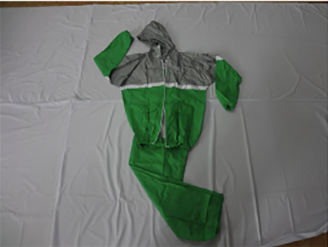nov. . 27, 2024 01:51 Back to list
PVC Raincoat Manufacturing Process and Quality Assurance Techniques
The PVC Raincoat Factory A Blend of Innovation and Protection
In a world where climate change brings unpredictable weather patterns, the importance of reliable rain protection has surged. PVC raincoats, known for their durability and waterproof properties, have become a staple for outdoor enthusiasts and everyday city dwellers alike. This article delves into the workings of a PVC raincoat factory, shedding light on the manufacturing processes, innovative technologies, and the environmental considerations that shape this industry.
Understanding PVC and Its Benefits
Polyvinyl chloride, or PVC, is a versatile plastic that is widely used in various applications, one of which is raincoat production. PVC raincoats are favored for their excellent waterproof capabilities, making them ideal for protecting against heavy rain while remaining lightweight and comfortable to wear. Additionally, PVC is resistant to mildew, making it suitable for prolonged outdoor use.
The manufacturing of PVC raincoats involves several stages, from the production of raw materials to the final quality checks before distribution. Understanding each step is crucial for appreciating the craftsmanship and technology that goes into creating a high-quality product.
The Manufacturing Process
1. Raw Material Preparation The process begins with the selection of high-quality PVC materials. Manufacturers source PVC resin and various additives that enhance the strength, flexibility, and durability of the final product. These materials are crucial as they determine the performance of the raincoat.
2. Mixing and Compounding The PVC resin is mixed with additives such as plasticizers, stabilizers, and colorants. This mixture is then processed in a specialized compounding machine, which ensures a uniform blend. The resulting compound is crucial for achieving the desired characteristics in the finished raincoat.
3. Extrusion and Coating After compounding, the mixture undergoes extrusion, where it is transformed into sheets or films through heated molds. For raincoats, the manufacturing process often includes a coating stage, where the PVC film is applied to a fabric base. This combination provides added durability and comfort, making the raincoat more wearable.
pvc raincoat factory

4. Cutting and Sewing Once the fabric is ready, it's cut into various patterns to fit different styles and sizes. Skilled workers then sew the pieces together, paying close attention to waterproof seams and closures. The quality of stitching is critical as it affects the raincoat's overall effectiveness in keeping water out.
5. Quality Control Before the raincoats are packaged, they undergo rigorous quality control checks. These tests assess the integrity of the seams, the waterproofing effectiveness, and the overall fit and finish. Ensuring that each raincoat meets industry standards is vital for maintaining customer trust and satisfaction.
Innovations in PVC Raincoats
In recent years, the PVC raincoat industry has embraced innovations that cater to the evolving needs of consumers. Manufacturers are increasingly focusing on eco-friendly practices, utilizing recycled PVC materials and environmentally-safe additives. Additionally, technological advancements have led to the development of lighter, more breathable PVC fabrics, enhancing comfort without sacrificing protection.
Smart raincoats, equipped with features such as UV protection and adjustable ventilation systems, have also emerged, appealing to tech-savvy consumers. These innovations aim to create a balance between functionality, style, and sustainability.
Environmental Considerations
As the demand for PVC raincoats grows, so do concerns about the environmental impact of PVC production. Factories are actively seeking ways to minimize waste and reduce emissions through improved processes and the adoption of greener technologies. Initiatives like recycling programs and the use of biodegradable packaging are essential steps toward creating a more sustainable production model.
Conclusion
The PVC raincoat factory stands at the intersection of innovation and necessity, producing essential products that provide protection against the elements. Through a rigorous manufacturing process, commitment to quality, and responsiveness to environmental challenges, the industry continues to thrive. As consumers increasingly value sustainability, the future of the PVC raincoat will likely reflect a broader trend toward eco-conscious production, ensuring that these useful garments remain a staple in wardrobes around the world.
-
Kids PVC/PEVA Rain Poncho - 100% Waterproof with Hoodie
NewsAug.07,2025
-
Durable PEVA Pet Body Bag | 45x55CM | Custom Printing
NewsAug.06,2025
-
White PEVA PVC Pet Body Bag with Handle | Durable Portable
NewsAug.05,2025
-
White PEVA PVC Pet Body Bag w/Handle - Eco-Safe & Durable
NewsAug.04,2025
-
PVC/PEVA Waterproof Rainwear - Lightweight Protection
NewsAug.02,2025
-
Premium Post Mortem Bags with AI Tech | 55 chars
NewsAug.01,2025





